Full Text: Report on China's Economic and Social Development Plan
REPORT ON THE IMPLEMENTATION OF THE 2010 PLAN FOR
NATIONAL ECONOMIC AND SOCIAL DEVELOPMENT
AND ON THE 2011 DRAFT PLAN FOR NATIONAL
ECONOMIC AND SOCIAL DEVELOPMENT
Fourth Session of the Eleventh National People's Congress
March 5, 2011
National Development and Reform Commission
Content
I. Implementation of the 2010 Plan for National Economic and Social Development
II. Overall Requirements and Major Objectives for Economic and Social Development in 2011
III. Major Tasks and Measures for Economic and Social Development in 2011
Fellow Deputies,
The National Development and Reform Commission has been entrusted by the State Council to report on the implementation of the 2010 plan and on the 2011 draft plan for national economic and social development for your deliberation and approval at the Fourth Session of the Eleventh National People's Congress (NPC), and also for comments and suggestions from the members of the National Committee of the Chinese People's Political Consultative Conference (CPPCC).
I. Implementation of the 2010 Plan for
National Economic and Social Development
Last year, the environment for China's economic and social development was extremely complex, and there were various extremely severe natural disasters and major challenges. Under the firm leadership of the Communist Party of China (CPC), the people of all our ethnic groups thoroughly applied the Scientific Outlook on Development. Based on the plan for national economic and social development adopted at the Third Session of the Eleventh NPC, we steadfastly implemented the package plan for responding to the global financial crisis, accelerated the transformation of the pattern of economic development, and consolidated the good momentum in economic and social development. Overall, the plan for 2010 was implemented well, and the main objectives and tasks set forth in the Eleventh Five-Year Plan were successfully accomplished.
1. Steady and rapid economic growth was maintained.
Economic performance was generally stable, with significant improvement in quality and efficiency. GDP for the year was 39.8 trillion yuan, an increase of 10.3%, and 2.3 percentage points higher than the target. Primary, secondary and tertiary industries grew by 4.3%, 12.2% and 9.5% respectively, and 0.3, 4 and 0.8 percentage points higher than targeted figures. Value-added of industry amounted to 16 trillion yuan, up 12.1% and 4.1 percentage points higher than the target. By strengthening regulation and overall coordination of supplies of coal, electricity, oil, gas and transport, we were able to meet all the demands of economic and social development and people's lives, demands from disaster-stricken areas and major events, and demands placed on us at crucial times. National revenue for 2010 was 8.3 trillion yuan, an increase of 21.3%. The deficit was 50 billion yuan less than the budgeted amount. The broad money supply (M2) increased by 19.7% and RMB loans totaling 7.95 trillion yuan were granted in 2010. The performance of enterprises continued to improve, and the profits of large industrial enterprises reached 3.88 trillion yuan in January through November, a year-on-year increase of 49.4%.
Figure 1
GDP Growth in the Eleventh Five-Year Plan Period

Domestic demand continued to expand, and the driving forces of economic growth became increasingly coordinated. Policies to stimulate consumer spending achieved positive results and the country's consumption potential was further unleashed. Retail sales of consumer goods totaled 15.6998 trillion yuan, a year-on-year increase of 18.3%, and 3.3 percentage points higher than the target. A total of 77.18 million home appliances, an increase of 130%, were sold through the national program for subsidizing rural residents' purchase of home appliances. A total of 18.06 million motor vehicles were sold, an increase of 32.4%. Appropriate growth was maintained in investment and the investment structure was further improved. Fixed-asset investment across the country amounted to 27.814 trillion yuan, up 23.8% from the previous year and exceeding the target figure by 3.8 percentage points. The plan to increase investment by four trillion yuan over two years was successfully completed. Guidelines on encouraging and guiding the sound development of nongovernmental investment were issued and implemented, which injected new vitality into investment from nongovernmental sources. In 2010, nongovernmental investment accounted for 51.1% of total fixed-asset investment in urban areas, 3 percentage points higher than the previous year. Consumption contributed 3.9 percentage points to economic growth, investment contributed 5.6 percentage points, and net exports contributed 0.8 percentage points.
Figure 2
Public Investment from the Central Government
from the Fourth Quarter of 2008 to 2010
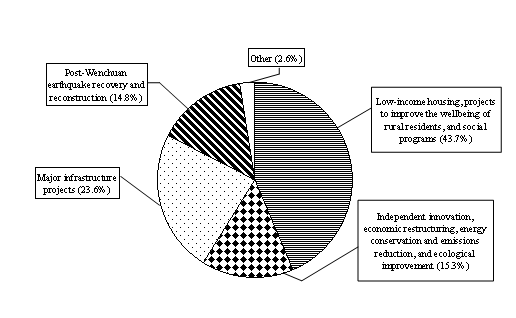
Overall price levels remained basically stable and markets were further standardized. We implemented a number of measures to keep prices stable and improve people's lives. We did a good job of stockpiling and releasing grain, cotton, meat, sugar and other important commodities; increased the varieties of fresh and live agricultural products that qualify for the toll-free policy and extended the policy to all toll roads; improved the mechanism to adjust living allowances for the poor in step with price changes, and therefore reduced the impact of price rises on their lives; suspended or eliminated some charges and fees, reduced the levels of others and lowered drug prices, thereby easing the burden on enterprises and the people; and organized and launched campaigns to rectify unreasonable charges and fees related to enterprises, electricity rates and prices of agricultural products, and to crack down on violations of intellectual property rights and on the production and sale of counterfeit or substandard goods in order to create a well-ordered pricing and market environment. Overall, annual CPI rose 3.3%, meaning the target for price control was basically achieved.
2. The agricultural foundation was consolidated.
Production of grain and other major agricultural products increased steadily. Despite severe droughts, low temperatures, scant sunlight, and serious floods in various areas, annual national grain output totaled 546.41 million tons, an increase of 15.59 million tons, up 2.9% from the previous year, and rising for the seventh consecutive year. Oilseed output was 32.39 million tons, up 2.7%. Livestock production was generally stable, the output of meat totaled 79.25 million tons, up 3.6%, and the output of aquatic products was 53.66 million tons, up 4.9%. Due to bad climatic conditions in some areas as well as reduced acreage, the output of cotton was 5.97 million tons, down 6.3%, and the output of sugar crops was 120.45 million tons, down 1.9%.
Figure 3
Increases in Grain Output over Seven Consecutive Years
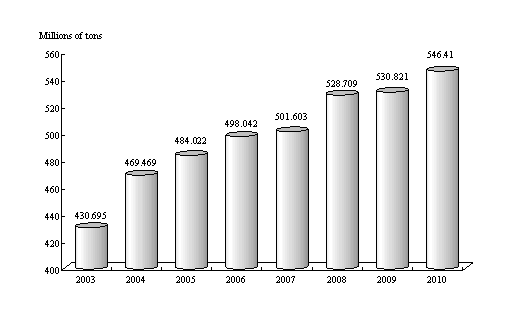
We effectively implemented policies to strengthen agriculture and benefit farmers. Annual central government spending on agriculture, rural areas and farmers totaled 857.97 billion yuan, up 18.3% from the previous year. This included 192.8 billion yuan of central budgetary investment used in agriculture and rural areas, making up 49% of the total central budgetary investment. We further intensified our efforts to protect farmland, improved over 1.3 million hectares of rural land, and more than 300,000 hectares of land was cultivated for the first time. We fully implemented the plan to increase China's grain production capacity by 50 million tons, and intensified development of cotton, edible oil and sugar production bases as well as work on the crop protection project, the animal epidemic prevention system and the project to cultivate superior varieties and breeds. We formulated and carried out policies to intensify the construction of small and medium-sized water conservancy facilities, promote agricultural mechanization and ensure the production and supply of vegetables. We completed all tasks included in the plan of reinforcing reservoirs and started implementing the second round of projects to reinforce dilapidated small reservoirs. We supported the construction of distribution infrastructure such as wholesale markets for agricultural products, grain and edible oils storage facilities, and cold-chain logistics for agricultural products. Compared with 2009, the average minimum purchase prices for wheat and rice increased by 3 yuan and 6 yuan per 50 kilograms respectively; we successfully implemented a policy for temporarily purchasing and stockpiling soybeans and canola seeds; and there were sufficient supplies of chemical fertilizers. The four kinds of subsidies to grain growers amounted to 122.6 billion yuan.
Figure 4
Central Government Investment in Agriculture, Rural Areas and Farmers in the Eleventh Five-Year Plan Period
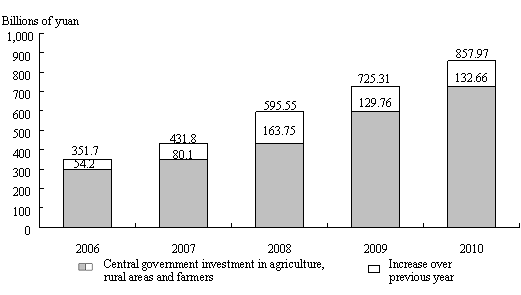
Rural working and living conditions continued to improve. In 2010, we provided safe drinking water to an additional 61.86 million rural residents and to teachers and students at rural schools, making safe drinking water available to 71.3% of the rural population. An additional 300,000 kilometers of electric power lines were installed in the countryside. Altogether, 96% of towns and townships and 81% of villages are now connected to asphalt roads. We supported the construction of 1,343 large and medium-sized methane projects, providing methane to another 5 million households nationwide. We renovated dilapidated houses for 1.2 million rural households, thereby meeting the planned target. Another 100,000 stores were set up in the countryside under the project to get retailers to open stores in more townships and villages, and a rural network of chain stores began to take shape.
Figure 5
Increases in Population Who Benefited from the Safe Drinking Water Project
in the Eleventh Five-Year Plan Period

3. Economic restructuring was carried out vigorously.
China's capacity for independent innovation increased. Good progress was made in implementing 16 key state science and technology programs together with the March 1997 Program for Basic Research, the March 1986 High-Tech Program and the National Key Technology R&D Program. Construction on the Shanghai Synchrotron Radiation Facility, the National Center for Nanoscience and Technology and other major science projects was completed and passed acceptance inspection. The third phase of the Knowledge Innovation Program in the Chinese Academy of Sciences was basically completed. Smooth progress was made in carrying out major projects such as building 50 national engineering centers, 32 national engineering laboratories and 56 key national laboratories seated in enterprises in areas such as digital television and next-generation Internet, as well as manufacturing advanced-generation LCD panels, large-scale integrated circuits and regional aircraft. Further progress was made in the development of large aircraft. An additional 93 enterprise technology centers received state recognition, 550 enterprises were now included in the national pilot program to support innovative enterprises, and the national pilot projects for innovation-oriented cities were carried out in 45 cities. The calculating speed of the high performance Tianhe-1 supercomputer, which was developed independently, is ranked first in the world.
High-tech industries developed more quickly. The value-added of the high-tech manufacturing industry for the year rose 16.6%, up 8.9 percentage points from the previous year. The output of major high-tech products increased considerably, with output of integrated circuits growing by 57.4%, electronic components by 30.1%, microcomputers by 35% and mobile telecommunication handsets by 46.4%; and the sales of software came to 1.3 trillion yuan, up 30%. Trade volume in the technology market exceeded 300 billion yuan. We promulgated and implemented the Decision on Accelerating the Cultivation and Development of Strategic Emerging Industries; actively moved forward with seven projects to apply high technology to production, including the project to promote modern practices in traditional Chinese medicine; built 18 national high-tech industrial bases; and set up 13 venture capital funds.
Fresh progress was made in industrial restructuring. We continued to implement the plan for restructuring and invigorating key industries, allocated a fund of 20 billion yuan for invigorating such industries and upgrading their technologies, and supported 5,051 technological upgrading projects. The relocation of the Shougang Group was completed smoothly, and substantive progress was made in reorganizing the Angang Steel Company Ltd. and the Pangang Group Company Ltd. We promulgated and implemented guidelines on accelerating the restructuring of the pharmaceutical industry. We completed all tasks of closing down backward production facilities. We shut down such facilities at thermal power plants with a total capacity of 12.1 million kilowatts, 2.1 million kilowatts more than planned; steel mills of 9.31 million tons, 3.31 million tons more than planned; iron foundries of 40 million tons, 15 million tons more than planned; cement plants of 116.19 million tons, 66.19 million tons more than planned; plate glass plants of 552,500 tons, 252,500 tons more than planned; and paper mills of 4.72 million tons, 4.19 million tons more than planned.
The service sector developed steadily. We launched trials of comprehensive reforms in the service sector, used funds for guiding development of the service sector to help accelerate the development of key areas and weak links of the sector, and promulgated and implemented guidelines on promoting development of the energy conservation service industry. In 2010, the service sector constituted 34.8% of the country's employment, and the value-added of the sector accounted for 43% of GDP.
Figure 6
Value-added of the Service Sector in the Eleventh Five-Year Plan Period

Infrastructure and basic industries became better able to meet demands made on them. Nationwide, 4,986 kilometers of railway lines were put into operation, raising the total to 91,000; 120,000 kilometers of highways were opened to traffic, raising the total to 3.98 million; 500 kilometers of high-grade inland waterways were opened to navigation, raising the total to 10,000; 125 deepwater seaport berths were put into service, raising the total to 1,774; and 9 new civilian airports were put into service, raising the total to 175. Some 1.66 million kilometers of optical cables were installed, raising the total to 9.95 million kilometers; and 49.24 million broadband Internet access ports were opened up, raising the total to 188 million. We intensified the construction of key energy projects, energy bases, and storage and transportation facilities. Eleven out of 13 large coalmining bases have already reached a production capacity of 100 million tons. A number of clean-energy projects were completed and put into operation; construction of the second phase of the state petroleum reserves project was accelerated; and total power transmission capacity of the northern, central and southern routes of the project to send electricity from the west to the east exceeded 78 million kilowatts. The annual output of raw coal was 3.24 billion tons, up 8.9%; crude oil output was 203 million tons, up 7.1%; natural gas output reached 96.76 billion cubic meters, up 13.5%; and electricity generation totaled 4.2065 trillion kilowatt-hours, up 13.2%.
Regional development became better balanced. We deepened the implementation of the overall strategy for regional development, and promulgated and implemented the national plan for development priority zones.
We smoothly introduced the guidelines on thoroughly implementing the strategy for large-scale development of the western region; promulgated and implemented the guidelines on promoting leapfrog development and long-term stability of Tibet and Xinjiang as well as on accelerating the development of Tibetan ethnic areas in Sichuan, Yunnan, Gansu and Qinghai; and approved the establishment of the Liangjiang New Area in Chongqing. Construction began on another 23 major projects for the large-scale development of the western region, with total investment reaching 682.2 billion yuan.
We increased support for optimizing and upgrading the industrial structure and developing modern service industries in northeast China, formulated the guidelines on supporting the region in developing modern agriculture, and further improved the policy framework for sustainable development of resource-dependant cities.
We fully implemented the plan to energize the development of the central region, accelerated the development of three different types of production bases and a system of integrated transportation hubs in the region, and introduced the guidelines on promoting the development of city clusters in the central region as well as the plan to establish demonstration zones for relocating industries to the central region in the city cluster along the Yangtze River in Anhui. The Wuhan metropolitan area; the Changsha-Zhuzhou-Xiangtan city cluster; city clusters in the central plains; the Poyang Lake Ecological Economic Zone; and the city cluster around Taiyuan in Shanxi, all played a bigger role in driving the development of their surrounding areas. Further progress was made in relocating industries to the central and western regions.
We actively promoted upgrading of the industrial structure and independent innovation in the eastern region; accelerated reform and opening up in Shenzhen and other special economic zones, the Pudong New Area in Shanghai and the Binhai New Area in Tianjin; promulgated and implemented the plan to stimulate the development of the Yangtze River Delta; and launched the national pilot program to develop the marine economy.
More support was given to old revolutionary base areas, ethnic minority areas, border areas and poverty-stricken areas. In 2010, the central government arranged 5.5 billion yuan for investment in work-relief schemes and a fund of 2 billion yuan on the pilot project to relocate people from inhospitable areas as a poverty relief measure. As a result, 870,000 people were relocated, 110,000 more than planned; and over 9.09 million rural residents were lifted out of poverty, basically reaching the target.
4. Significant progress was made in energy conservation and environmental protection and in responding to climate change.
We basically met the targets for energy conservation and emissions reductions. In 2010, investment funds from the central government budget for this purpose came to 33.3 billion yuan, an increase of 140% over the previous year; and the central government provided 51.8 billion yuan in special funding for conserving energy and reducing emissions, up 73%. We actively carried out the ten major energy conservation projects, capable of generating energy savings equivalent to 33.1 million tons of standard coal. We worked hard to implement the project to promote energy-efficient products for the benefit of the people, and nearly 30 million high-efficiency air-conditioners, over 1 million energy-efficient motor vehicles, and 160 million energy-saving light bulbs were put into use. We started to implement the pilot project to demonstrate and popularize new energy vehicles. We actively developed national demonstration bases for recovering mineral resources from city waste. We supported the construction of urban sewage and garbage treatment facilities. For the whole year, daily urban sewage treatment capacity increased by 19 million cubic meters and daily urban household waste disposal capacity grew by 68,000 tons; and 76.9% of urban sewage was treated and 72.5% of urban household waste was safely handled, an increase of 1.6 and 1.2 percentage points year on year respectively. In 2010, energy consumption per unit of GDP fell 4.01%; sulfur dioxide emissions and chemical oxygen demand dropped 1.32% and 3.08% respectively; water consumption per 10,000 yuan of value-added of industry fell 9.6%; and the percentage of industrial solid waste that was comprehensively utilized rose by 2 percentage points. Over the past five years, energy consumption per unit of GDP fell 19.06%, sulfur dioxide emissions and chemical oxygen demand decreased 14.29% and 12.45% respectively, water consumption per 10,000 yuan of value-added of industry decreased 36.7%, and the targets set in the Eleventh Five-Year Plan were either basically met or exceeded.
Figure 7
Energy Consumption per Unit of GDP in the Eleventh Five-Year Plan Period

*Energy consumption per unit of GDP equals 100 in 2005.
Figure 8
Sulfur Dioxide Emissions and Chemical Oxygen Demand
in the Eleventh Five-Year Plan Period
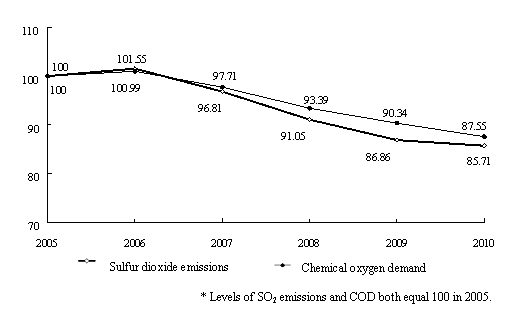
New steps were taken in ecological and environmental protection. We further consolidated progress previously made in returning cultivated land to forests and grazing land to grasslands; completed the first phase of the project to protect virgin forests; completely stopped commercial logging in natural forests in the upper reaches of the Yangtze River and the middle and upper reaches of the Yellow River; and protected and restored biodiversity. In 2010, an additional 5.92 million hectares of land was afforested, 6.667 million hectares of grazing land was returned to grasslands, and soil erosion on 42,000 square kilometers of land was brought under control through combined measures nationwide. We promulgated and implemented a comprehensive national plan for water resources. We vigorously carried out pollution control in the key watersheds of the Huai, Hai, Liao and Songhua rivers; the Tai, Chao and Dianchi lakes; the middle and upper reaches of the Yellow River; the Three Gorges Reservoir area and its upper reaches; the Bohai Sea; and the Danjiangkou Reservoir area and its upper reaches. We fully implemented the master plan for the comprehensive cleanup of the water in the Tai Lake basin.
Figure 9
Area Afforested in the Eleventh Five-Year Plan Period

The work of responding to climate change was further strengthened. We effectively implemented China's National Climate Change Program, actively made innovations in low-carbon technology, and smoothly carried out pilot projects for low-carbon provinces and low-carbon cities. We successfully held the Tianjin United Nations Climate Change Conference, and actively engaged and participated in international exchanges and cooperation in all areas.
5. Reform and opening up were further intensified.
New breakthroughs were made in reforming major areas and key links.
In terms of rural reforms, we launched the reform of tenure in collective forests in an orderly manner and devolved the tenure of more than 80% of the country's collective forests to rural households, and made steady progress in the trial reform of state forestry farms and in restructuring state farms built on reclaimed land.
In terms of enterprise reforms, the reform to institute a corporate system or a stockholding system was carried out in over 70% of the central state-owned enterprises (SOEs) and enterprises subordinate to them, and the pilot project for standardizing boards of directors was extended to 32 central SOEs. We made further progress in reforming the power industry, postal services and public utilities. We also promulgated and implemented a number of supporting policies to promote the development of the non-public sector and small and medium-sized enterprises.
In terms of reforming the fiscal and taxation systems, we implemented the reform to place county finances directly under the management of provincial governments in 970 counties across 27 provinces; conducted trials in the western region on the reform of resource taxes on oil and natural gas; and extended the urban construction and maintenance tax and education surcharge to foreign enterprises and nationals.
In terms of reforming the financial system, steady progress was made in reforming the China Development Bank, policy-based financial institutions and asset management companies; the Agricultural Bank of China was listed successfully; stock index futures were launched; corporate bonds developed steadily; the reform of the RMB exchange rate regime continued; and the RMB was used more widely in cross-border trade.
In terms of reforming the prices of resource products, we made smooth progress in trials of publicizing the costs of supplying water in cities and of a comprehensive price reform of water for agricultural purpose; introduced a punitive electricity rate on products exceeding limits of energy consumption per unit of production; and set a unified rate for on-grid electricity generated from agricultural and forest biomass.
In terms of reforming social programs, we deepened the five key reforms in the pharmaceutical and healthcare systems; implemented the national system for basic drugs in 60% of primary-level medical and health care institutions run by the government; vigorously explored and constantly deepened the reform of public hospitals in 16 state-designated trial cities and 37 province-designated trial areas; and introduced the guidelines on further encouraging and guiding nongovernmental capital toward medical institutions. We comprehensively launched the national pilot program for restructuring the education system, and thoroughly implemented the performance-based pay reform for compulsory education schools. We pushed forward with the reform of the cultural management system in an orderly manner, and basically completed trials on turning provincial-level state-owned theatre troupes into corporations and the transformation of for-profit publishing houses into enterprises. Positive results were made in national pilot projects to carry out integrated, complete reforms.
The development level of the open economy was raised further. We adhered to the strategies of diversifying markets and competing on quality; tightened control over exports of resource products and products whose production is energy-intensive or highly polluting; increased imports of raw materials in short supply on the domestic market, energy-intensive products, advanced technology, and key spare parts and components; and eased the trade imbalance. Total import and export volume reached US$2.97276 trillion in 2010, an increase of 34.7%. Exports rose 31.3%, imports rose 38.7%, and the trade surplus was down 6.4% from the previous year. We introduced the guidelines on better utilizing foreign investment and guided foreign investments toward high-end manufacturing, high-tech industries, modern service industries, new energy sources, energy conservation and environmental protection industries, and the central and western regions. Utilized foreign direct investment in 2010 (excluding the banking, securities and insurance sectors) totaled $105.74 billion, up 17.4%. Disbursed foreign loans reached $20.5 billion, up 57%. We vigorously implemented the "go global" strategy and made further progress in a number of major outward investment projects. Non-financial outward direct investment for the year amounted to $59 billion, an increase of 36.3%. Receipts from overseas project contracting operations reached $92.2 billion, an increase of 18.7%.
6. Efforts to ensure and improve the people's wellbeing were comprehensively strengthened.
Urban and rural incomes continued to grow. Urban per capita disposable income and rural per capita net income reached 19,109 yuan and 5,919 yuan respectively, up 1,934 yuan and 766 yuan, or 7.8% and 10.9% from the previous year in real terms after adjusting for inflation, and 1.8 and 4.9 percentage points higher than the target figures. This is the first time since 1998 that rural income growth has surpassed urban income growth.
Figure 10
Real Growth in Urban and Rural Incomes in the Eleventh Five-Year Plan Period
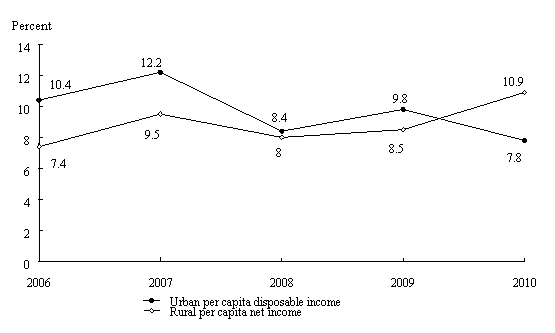
Employment grew steadily. We intensified the implementation of a proactive employment policy. We improved primary-level public service facilities for employment and social security, and set up 162 county-level and 610 township-level service centers in the central and western regions. Over the year, 11.68 million urban residents entered the workforce for the first time, exceeding the target by 2.68 million, and the urban registered unemployment rate was 4.1%, which met the target.
The level of social security continued to rise. By the end of 2010, the number of urban participants in basic pension insurance reached 256.73 million, 16.73 million more than planned; and we extended the trials of a new pension insurance system for rural residents to 24% of the country's counties. The methods for transferring basic pension accounts for employees of urban enterprises and transferring basic medical insurance accounts for migrant workers were implemented smoothly. Basic medical insurance covered 432.06 million urban residents, an increase of 30.59 million over the previous year; and 835 million rural residents, or 96.3% of the rural population, signed up for the new rural cooperative medical care system, 2.1 percentage points higher than the previous year. We raised the standards of subsistence allowances for urban and rural residents, unemployment insurance benefits, the basic pension for enterprise retirees, subsidies and living allowances to entitled groups, and government aid to students from poor families. Post-disaster recovery and rebuilding work progressed smoothly, the three-year post-Wenchuan earthquake recovery and reconstruction tasks were basically completed within two years, and the recovery and rebuilding work is well underway in Yushu and Zhugqu.
Figure 11
Participation Rates in the New Rural Cooperative Medical Care System
in the Eleventh Five-Year Plan Period
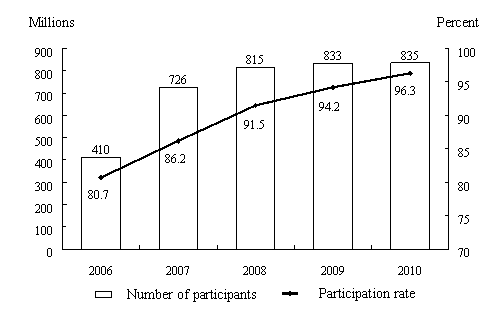
The development of low-income housing projects was carried out on a large scale. The central government further raised subsidies for building low-rent housing and renovating rural dilapidated houses in the central and western regions, expedited the development of public rental housing, and included it in the low-income housing program. In 2010, work was begun to build low-income housing and renovate run-down areas across the country with a total of 5.9 million units, surpassing the target by 100,000 units. This figure consists of 3.22 million units of low-income housing and 2.68 million units of housing in run-down areas; and throughout 2010 work was basically completed on 3.7 million units.
Social development was strengthened.
The National Medium- and Long-Term Plan for Education Reform and Development and the National Medium- and Long-Term Plan for Human Resources Development were promulgated and implemented. A total of 13.25 million square meters of primary and secondary school buildings were renovated in rural areas, and construction was completed on 2.12 million square meters of secondary vocational school buildings. The goals of making nine-year compulsory education universally available and basically eliminating illiteracy among young and middle-aged adults were attained for 100% of the target population in the country. The junior secondary school retention rate reached 94%. The secondary gross enrollment ratio reached 82.5%, up 3.3 percentage points. The tertiary gross enrollment ratio was 26.5%, with 6.618 million undergraduate students and 538,000 graduate students enrolled.
Smooth progress was made in developing the medical and health service system. We supported the construction and renovation of 891 county-level hospitals, 1,620 central health clinics in towns and townships, 1,228 community-based health service centers and 116 institutions for preventing and treating mental health problems. The natural population growth rate of about 5‰ met the target, and the national population reached 1.341 billion at the end of 2010.
Steady progress was made in the project to extend radio and television coverage to all villages, the construction of multipurpose cultural centers in towns and townships, the Tibet-Xinjiang Project, and the national cultural information resource sharing project. Work on major cultural projects such as the National Museum of China and the National Theater Company of China proceeded smoothly, and the number of public museums, memorial halls, and patriotic education centers across the country opened to the public free of charge reached 1,743.
We improved infrastructure at major tourist attractions, and actively worked to turn Hainan into an international tourist island. Philosophy and the social sciences, the press and publishing, and literature and art all flourished. The Shanghai World Expo was a complete success, and a total of 246 countries and international organizations participated -- more than any other world expo in history. We successfully hosted the Guangzhou Asian Games and Asian Para Games. Recreational sports work entered a new stage, and over 230,000 sports and fitness projects were completed for rural residents. Social welfare programs developed more rapidly, and the number of beds in social service institutions reached 3.123 million, up 4.3%.
Despite a complex and volatile economic environment abroad and frequent natural disasters at home, China's economy maintained steady and rapid development in 2010, and we further consolidated the momentum of our economic turnaround. These achievements did not come easily. They were the result of the overall planning and firm leadership of the Party Central Committee and the State Council, as well as the conscientious implementation of the central leadership's principles and policies, close collaboration and hard work of all localities and departments. They were also attributable to the concerted efforts of the people of all our ethnic groups in tackling difficulties head-on. After five years of efforts, of the 22 major targets for economic and social development set forth in the Eleventh Five-Year Plan, all eight obligatory targets were met and we achieved all the other 14 anticipated targets except three -- the proportion of employment in the service sector, the proportion of value-added of the service sector contributed to GDP, and the spending on R&D as a percentage of GDP.
As we look at these achievements, we must also be keenly aware that there are still some serious conflicts and problems facing domestic development.
First, the foundation for steady increases in grain production and rural incomes is not solid. Constraints from insufficient resources including farmland and fresh water are intensifying; water conservancy infrastructure remains weak; the overall level of agricultural science and technology is not high; the returns from agriculture have been comparatively low for a long time; and rural migrant workers still face institutional obstacles in seeking urban employment.
Second, our tasks for economic restructuring are arduous. Improving our capacity for independent innovation is constrained by inadequacies in incentive mechanisms and shortages of core technologies and highly talented people; haphazard investment and excess production capacity in certain fields is increasingly evident; eliminating backward production capacity is becoming more difficult; development of the service sector still lags behind; and unbalanced and uncoordinated development between urban and rural areas and between different regions remains a serious problem.
Third, there are strong inflationary pressures. Imported inflationary pressure is on the rise; there is loose liquidity in the market; hot money speculation is soaring; and increases in the costs of resources, land, labor and other factors of production have become a long-term stimulus to price rises. Last year, about 70% of price rises were due to growth in food prices, adding pressure on the lives of urban and rural residents, and especially low- and middle-income families. House prices rise too fast in some large and medium-sized cities, and it is still very hard for ordinary people to solve their housing problems on the market.
Fourth, resource and environmental constraints have intensified. Total energy and resource consumption is too large and is growing too quickly, and emissions of major pollutants are high. A permanent mechanism for saving energy and reducing emissions has yet to be established, and energy-intensive and highly polluting industries are still growing too fast. Consequently, we face mounting pressure to save energy, reduce emissions, and respond to climate change, and great challenges in sustainable development.
Fifth, social problems have increased. Our work on income distribution, social security, schooling, and medical care still fall considerably short of the demands of the people. Actions that harm people's interests in such areas as food and drug safety, land expropriation, housing demolition and resident relocation, and industrial safety are still occurring.
In addition, world economic recovery is a painstaking and tortuous process, some countries are saddled with huge debts and persistently high unemployment rates, global liquidity continues to increase, and international market prices for major commodities and exchange rates among major currencies remain in turmoil. All these instabilities and uncertainties have made it even more difficult to do this year's domestic work well.
We need to take all the above problems seriously and adopt effective measures to solve them.
 0
0 






